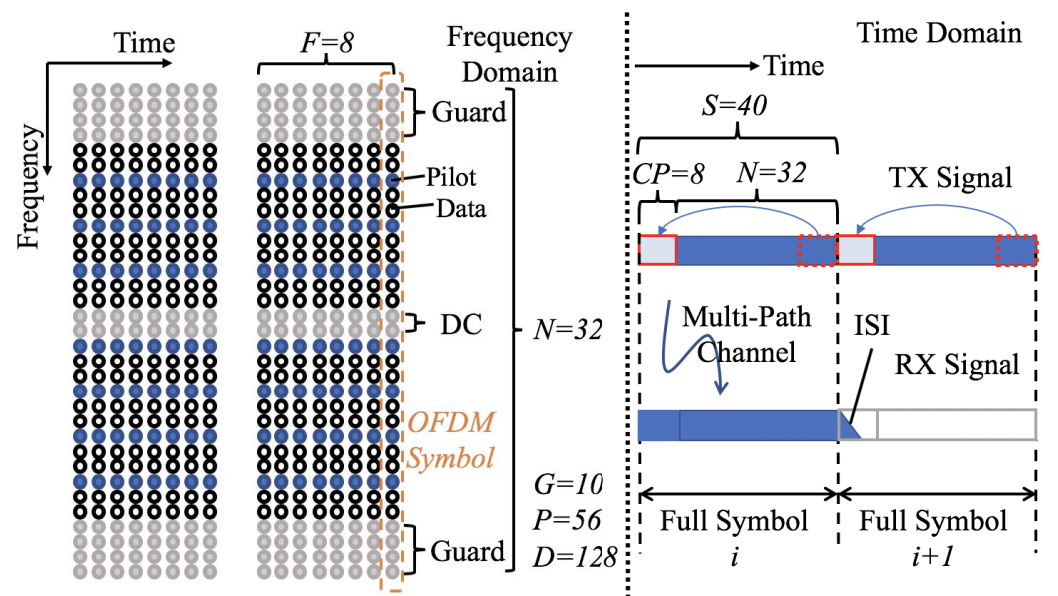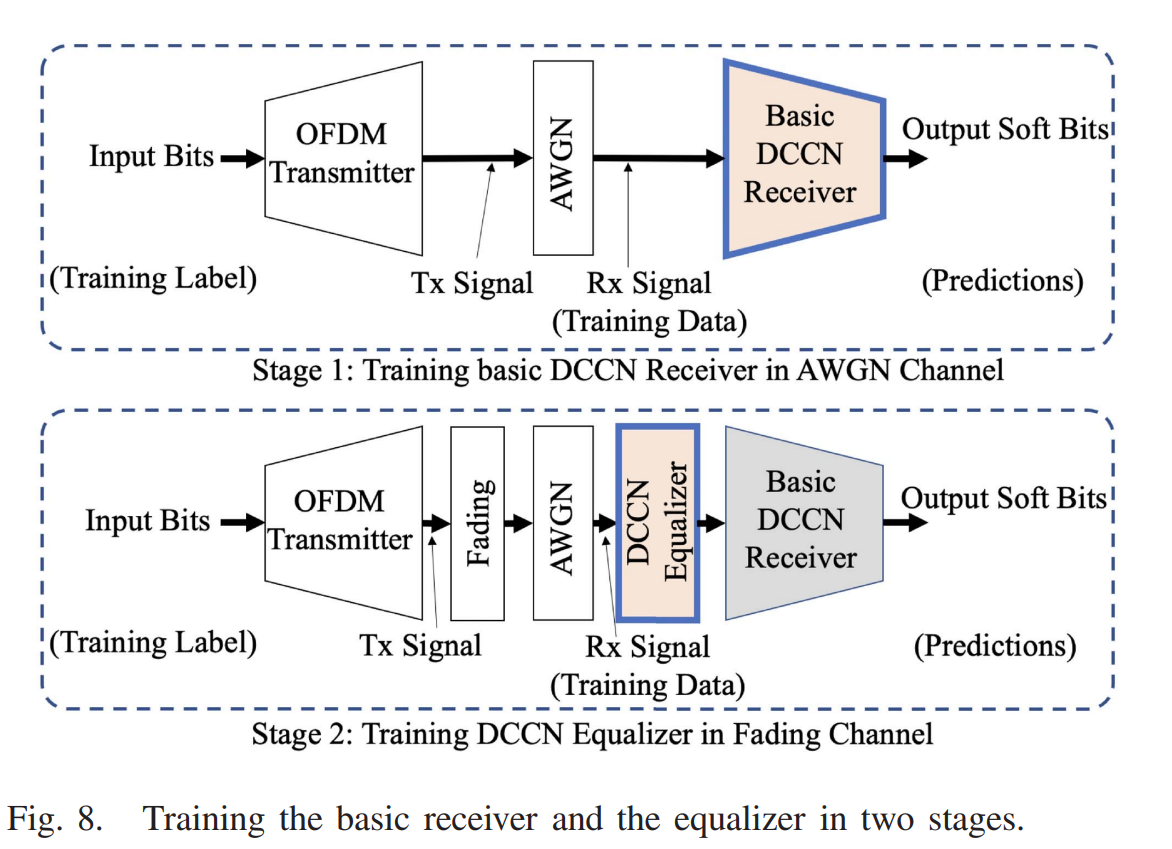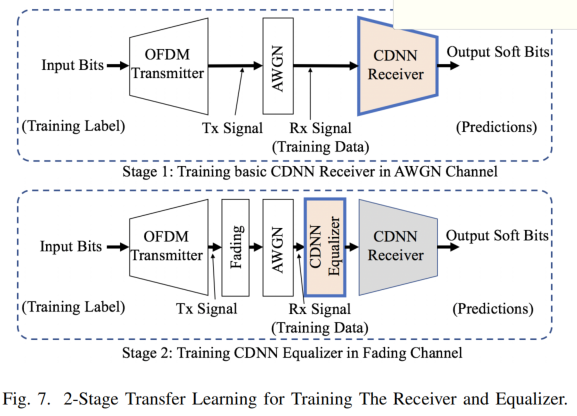OFDM Receiver Design and Complex Convolutional Networks
Deep-Waveform
Deep-Waveform: A Learned OFDM Receiver Based on Deep Complex-Valued Convolutional Networks. Zhongyuan Zhao et.al. IEEE Journal on Selected Areas in Communications, August 2021 (pdf) (Citations 25)
提出了一种利用deep complex-valued convolutional network 实现直接从时域信号解调OFDM bits的方案
- 结合CP-exploitation, channel estimation, and intersymbol interference,一起取得了比较好的效果
- 指导了新的方法进行复数运算
- 传统方案一:拼成两列
- 传统方案二:two channel
- Two stages for training in fading channel.
- 代码开源
Quick Overview
- Use a deep complex-valued convolutional network (DCCN) to recover bits from time-domain OFDM signals without relying on any explicit DFT/IDFT.
- has the advantage of combining CP-exploitation, channel estimation, and intersymbol interference.
- guidelines of exact and approximate implementations of a complex-valued convolutional layer are provided for the design and analysis of convolutional networks for wireless PHY.
- a suite of novel training techniques are developed to improve the convergence and generalizability of the trained model in fading channels.
The Authors claimed that process complex data in the $\mathbb{R}^2$ is differs from field in multiplicative operations.
And DCCN can:
- a learned linear transform to replace DFT/IDFT by exploiting its cyclic prefix (CP).
- a data-driven interpretable DCCN channel equalizer that outperformances the legacy receivers and lower complexity. Combine CP exploitation, intersymbol interference mitigation and channel estimation.
- a training methods to improve the convergence and generalizability of the DNN-based receiver in fading channel.
OFDM system
Diagram of legacy OFDM PHY

Exemplary OFDM coherence slot and time-domain waveform

An OFDM symbol contains subcarriers, and DC guard band and edge guard band among the subcarriers.
A subcarrier in an OFDM symbol (the yellow column) is refereed to as a resource element (RE). And a coherence slot contains OFDM symbols, with pilot REs and data REs, respectively.
The length of a time-domain full OFDM symbol is .
Channel estimation

Pilot signals are of either constant signal or low auto-correlation sequence (e.g., Zadoff-Chu sequence) known at the receiver. The basic pilot-aided channel equalizer in OFDM system is based on the least square (LS) estimator.
Whole Structure

And two stage training.

Simplify
Using the legacy data REs extraction and demodulation (Equalizer?)

Another paper/ old version https://arxiv.org/abs/1810.07181v3
- The model contains both dense and convolutional layers which are mostly linear activated, and new structures of residual and skip connections. (different from other works which only contain Fully-Connected layer and Relu activation.)
- complex convolutional layer is implemented within Tensorflow to process complex IQ data, instead of treating it as two independent real numbers.
Typical pilot patterns in OFDM system are: block, comb, and scattered

Basic OFDM Receiver (AWGN)
Firtstly, the author trains the basic DCCN OFDM receiver (i.e., without channel equalizer) for bit recovery.

- The first part includes first 3 layers, which is intended to transform time-domain OFDM symbol into frequency-domain. The major component of the first part is a Complex Conv (C-Conv) layer of size N × S(N) × 1.
- DCCN can drop CP by configuration. Dropping the CP before Complex 1D-Conv.
- The second part contains layers 4 to 6, which is intended to extract all the data cells of an OFDM frame, this is implemented by an FC layer.
- the real part and imaginary part are stored in the last dimension of the tensors.
- Part 3 is for demodulation, which is convert the complex IQ data into soft bits. The output of softmax activation are soft bits, which represents each bit with 2 real numbers (e.g. Log-Likelihoods of 0 and 1).
OFDM receiver Equalizer
- The equalizer usually located in the frequency domain to avoid the convolutional operator. Thus, the DFT-like component is located before the LS-like Equalization.

- The first (layer 0-5) and fourth parts (last 4 layers) are DFT/IDFT-like complex Conv layers intended to perform time/frequency domain transformation. The layer 3 and last 2 layer are used for CP removing and adding back.
- Part 2, from layers 6 to 19, is for channel estimation.
- Part 3, layer 20, is frequency domain channel equalization implemented by complex division: the output of part 1 (frequency domain receive signal) over the output of part 2 (channel estimates).
- LS-like channel equalizer
Training configurations
The Two-stage training configurations:

- It’s too complex to be trained together at one time.
- Firstly, training the basic OFDM receiver in AWGN channel without fading
- Then, Load the pre-trained basic OFDM receiver and insert the DCCN Equalizer before the DCCN OFDM receiver.
- Lastly, generate the Rx data with fading, and only the DCCN Equalizer is trained.
- Some tracks:
- mini batch
- to tensor
- small and decaying learning rate
- early stopping
The same loss function is used in the two stages. And the loss function is:

- The logarithmic BER could prevent diminishing gradient due to tiny changes of CE when BER is very small.
- Training SNR:

本文作者: Joffrey-Luo Cheng
本文链接: http://lcjoffrey.top/2024/01/18/OFDMReceiverandComplexConv/
版权声明: 本博客所有文章除特别声明外,均采用 CC BY-SA 4.0 协议 ,转载请注明出处!